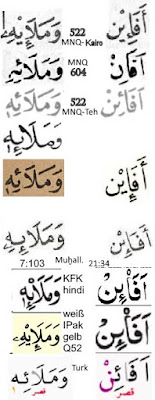Experts say,
that there are hundereds more alifs in Ottoman and Turkish prints
then in modern Arab and in Indian prints.
Although not outright wrong, I think it is stupid to say.
Why?
Because there is not one alif, but nine:
| |
Q52 IPak |
Q52 IPak |
Q52 IPak |
|
| There are |
leading |
middle |
trailing |
Alifs |
| hamza |
ء vsign |
ء ء |
ء ء |
|
| mater lec. |
‒ |
X |
X |
|
| silent |
waṣla X |
circle X |
circle X X X |
Alif wiqāya accusative marker |
In IPak a v(owel) sign on/below alif includes hamza
In spite of what the experts say,
there are not more alifs signifying or carrying hamza
‒ whether leading, in the middle or trailing,
nor more otiose/silent alifs.

Here Turks (last line) have the same silent alif; they shorten it, i.e. the fatḥa is valid, the alif is not.
BTW: In one of the three
maṣāḥif of Muṣṭafā Naẓīf the yāʾ is missing -> the alif carries the hamza+kasra (first line on the right side).

Here Turks (first line) actually have an otisose alif LESS (END of my snippet)
What these experts want to say:
There are more
Alif Matres lectionis, i.e. alifs standing for /a/.
 Here Turks (last line) have the same silent alif; they shorten it, i.e. the fatḥa is valid, the alif is not.
BTW: In one of the three maṣāḥif of Muṣṭafā Naẓīf the yāʾ is missing -> the alif carries the hamza+kasra (first line on the right side).
Here Turks (last line) have the same silent alif; they shorten it, i.e. the fatḥa is valid, the alif is not.
BTW: In one of the three maṣāḥif of Muṣṭafā Naẓīf the yāʾ is missing -> the alif carries the hamza+kasra (first line on the right side).
 Here Turks (first line) actually have an otisose alif LESS (END of my snippet)
What these experts want to say:
There are more Alif Matres lectionis, i.e. alifs standing for /a/.
Here Turks (first line) actually have an otisose alif LESS (END of my snippet)
What these experts want to say:
There are more Alif Matres lectionis, i.e. alifs standing for /a/.




No comments:
Post a Comment